Why Use A Diesel Heater in an RV?
When you can stay warm inside your RV without needing a lot of electricity, you can comfortably camp in colder weather.
Which means a longer camping season and more camping trips.
Related Product: Keep hot or cold air inside your RV by using Camco Vent Insulators (click to view on Amazon)
Diesel heaters are great options for RV and van heating because they use very little electricity, are 12 volt powered, and are a lot quieter than RV furnaces.
Permanent vs Portable Diesel Heaters
There are two main kinds of diesel heaters for RVs and vans.
The permanent option comes with a diesel heater, fuel pump, and fuel tank in separate pieces.
Permanent diesel heaters are great if you have a diesel fueled vehicle because you can tap into its fuel tank to run the heater.
The other type is the portable or all-in-one diesel heater.
This version comes with everything packed into a metal box.
It’s great for when a diesel fuel tank to tap into isn’t available or for those who want to be able to transfer it to different places.
See Also: 6 Best Diesel Heaters For Campers, RVs & Vans
I wanted to put a portable diesel heater in my motorhome.
But it’s a gas fueled RV, so the diesel heater needs its own fuel tank.
I also wanted to be able to move the heater to a tent, garage, or another RV easily.
My setup is made so I can quickly set up an all-in-one diesel heater in my RV when I need it, and take it out when I don’t.
So far my installation has worked well and I’m surprised by how quickly the 8kw diesel heater can heat my small RV.
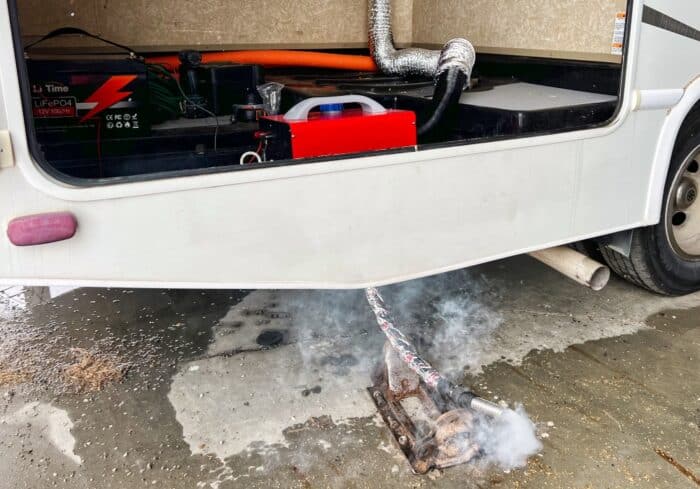
RV Storage Compartment Install
Portable diesel heaters aren’t ready to go right out of the box.
They require a little bit of initial setup because an air intake pipe and exhaust tube need to be installed.
A 12 volt power source is also required.
Install Overview
I installed my Vevor 8KW portable diesel heater (click to view current model Amazon) in a large storage compartment in my 24 foot Four Winds motorhome.
The storage compartment is a lot larger than what you see on most RVs.
It’s under the main bed which means it’s as long and wide as a queen size mattress.
Because it’s so spacious, it can easily fit my camping gear and still give enough space and airflow for the diesel heater to run properly and safely.
See Also: Best Small Portable Propane Heater For Indoor & RV Use
I installed the heater as close to the main storage door as possible so it would be easy to fill the fuel tank.
It also made it so the exhaust pipe wouldn’t need to be super long to stick out from underneath the motorhome.
I then installed a vent inside the RV.
It’s towards the back of the motorhome, but it’s in a good spot to heat the entire thing.
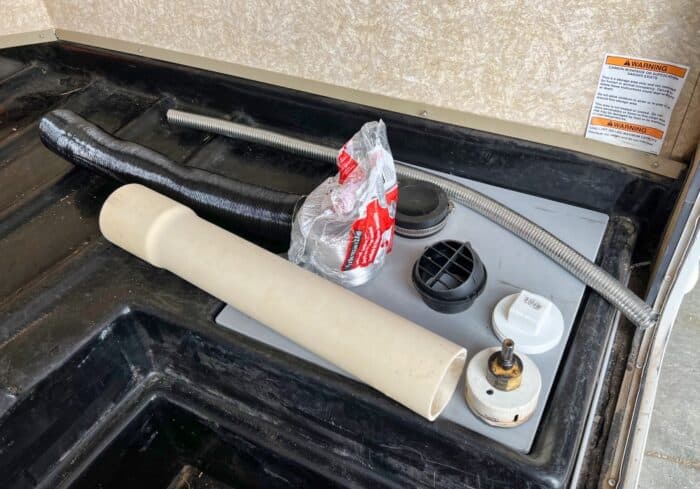
Parts Needed
(click links to view products on Amazon)
- Portable Diesel Heater
- Fuel Filter – if the heater didn’t come with one already installed (click here to see fuel filter installation post).
- Hole Saw – for installing inside vent and drilling hole for exhaust pipe, 3 inch works well.
- 3 inch Heat Duct Tubing
- 3 inch Pipe (if there’s a gap in the RV wall)
- Pipe Cap – for when the heater isn’t being used.
- 12 Volt Battery (can be RV battery or external battery)
- Floor Cap – for the exhaust hole in the storage compartment floor.
Optional
Power Source
While they don’t use a ton of power, diesel heaters require 12 volt power source to run the controls, heat the glow plugs, and power the fan.
When running they don’t usually use more than 40 watts of power.
But when starting up they will usually draw 8-13 amps depending on the size of the heater.
A 3 KW and maybe even 5 KW diesel heater usually won’t require more than 10 amps of power to start.
So you can plug them into portable power stations.
Portable power stations normally have a 10 amp 12 volt outlet already installed.
They are a popular choice for powering portable diesel heaters and it’s what I would use if my diesel heater drew less than 10 amps.
See Also: Best Portable Power Station/Solar Generator For Camping
Unfortunately, the 8KW diesel heaters often use around 13 amps to start.
Any 12 volt outlets I use have to be rated for at least 15 amps, and no power station I know of has more than a 10 amp 12 volt outlet.
There are a few options for powering a diesel heater in an RV.
You can connect it directly to the RV battery, use a separate battery that you place near the heater, install a 15-20 amp 12 volt outlet, or use the one inside your RV if there is one.
Right now, I’m just using an extra lithium battery that I place next to the heater inside the storage compartment.
Later, I plan on using 12 gauge wire and a 15 amp outlet to make an extension cord that’s long enough to reach a 12 volt outlet above the main bed in my motorhome.
That way the diesel heater will be powered by my RV battery and I can easily unplug it from inside.
I’ve heard that using an inverter to power a 12 volt diesel heater with AC power doesn’t work so well.
It’s recommended to use a 12 volt power source.
Exhaust Pipe
The most important part of a diesel heater installation is making sure the exhaust pipe can be installed in a safe spot.
Since this is a temporary set up the exhaust pipe needs to be easy to remove as well.
I have my portable diesel heater mounted on blocks of wood that are 4 inches tall to give a little extra room for the exhaust.
I drilled a 3 inch hole in the storage compartment so the pipe could be placed directly below the heater.
See Also: How To Stay Warm In An RV At Night Without Using The Furnace
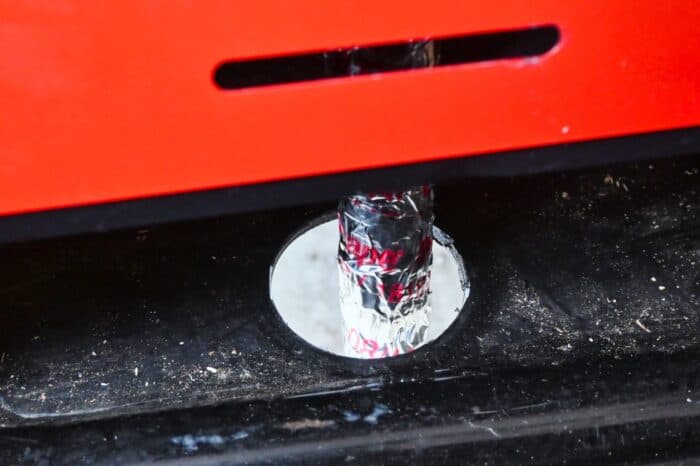
The storage compartment in my RV is made of plastic. So all I had to do was drill a hole through it.
Most other RV storage compartments will have plywood floors and there might be some insulation underneath.
You need to make sure you give the exhaust pipe enough space to not create a fire hazard.
Wrapping the pipe in exhaust wrap is a good way to keep it from getting extremely hot.
I wrapped the exhaust pipe for my diesel heater in both fiberglass heat wrap and aluminum tape so I could grab it without getting fiberglass on my hands.
The tape gets warm so I might remove it later and just use gloves whenever I need to move the exhaust pipe.
Interior Vent Installation
The installation of the inside vent is going to be a little different for everyone.
Sometimes there’s just a 1 inch piece of plywood between the RV storage compartment wall and the inside of the RV.
In this case, it would be easy to drill a hole that’s big enough for the vent that was included with the diesel heater.
The vent should be long enough to go through the plywood so you can clamp it directly to the air duct.
See Also: Best Portable Electric Heated Blankets For Camping
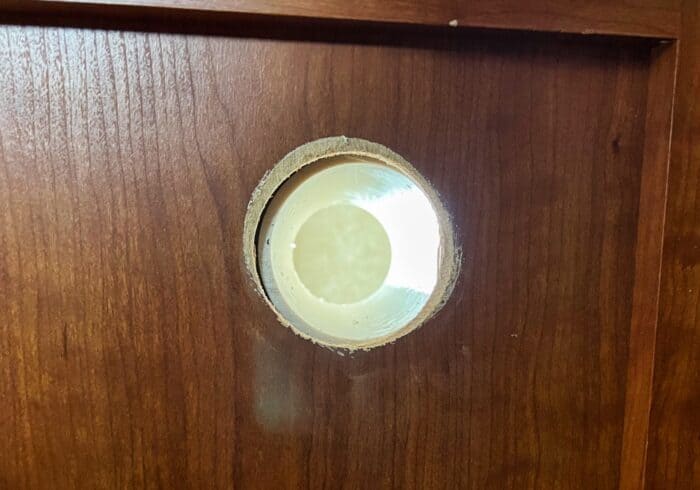
Since the storage compartment I was using was under the main bed, there was a 6 inch gap between the wall of the storage compartment and the interior wall.
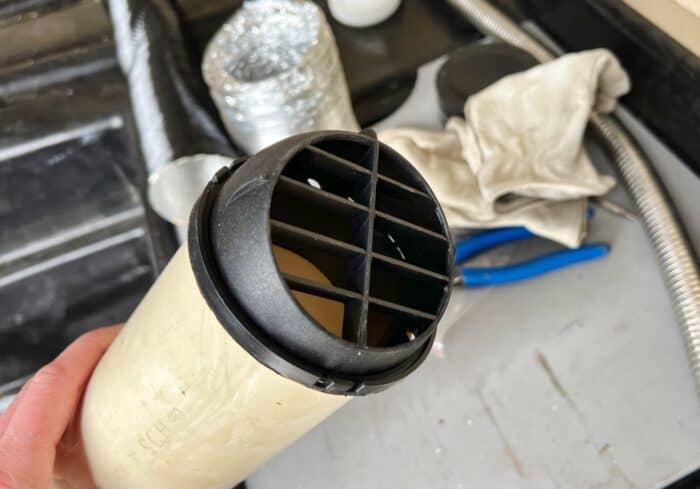
To make it work I used a 3 inch PVC pipe that the included vent fit inside perfectly.
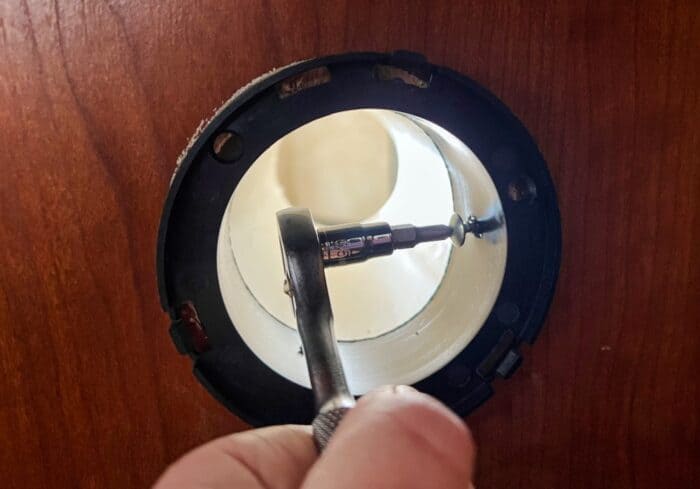
I used screws to secure the vent to the inside of the pipe to hold it in place.
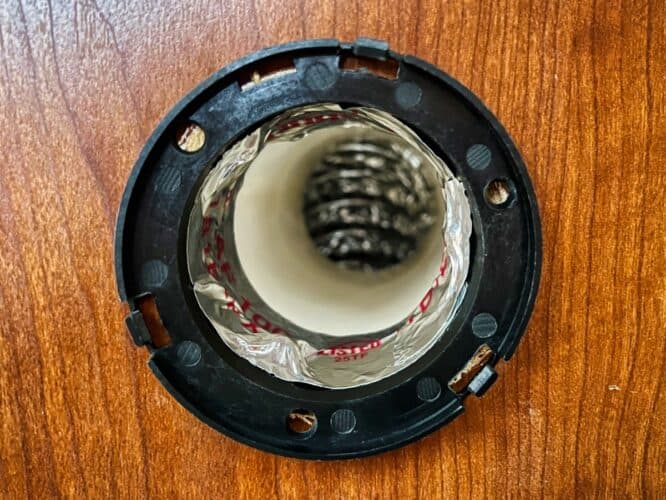
There was a little bit of a gap between the vent and the pipe that I sealed off with aluminum tape.
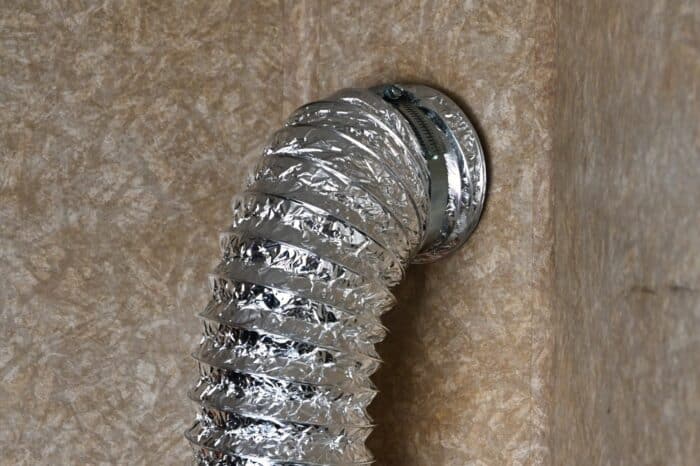
On the storage compartment side, I left enough pipe sticking out to easily secure the duct tubing.
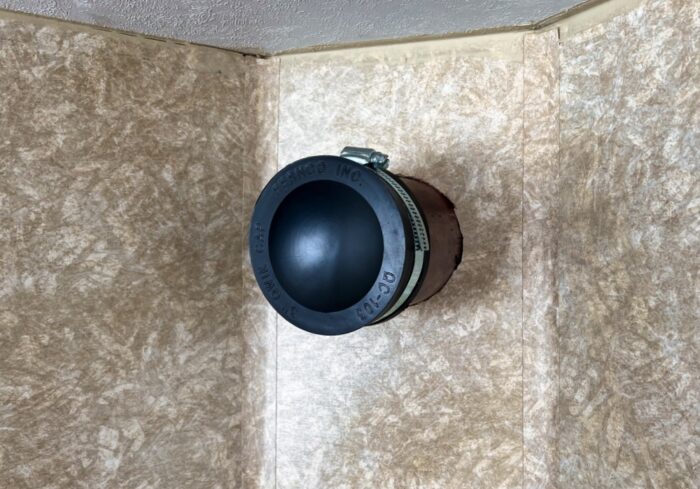
I also got a rubber cap to put on the pipe to seal off the storage compartment when I take out the diesel heater.
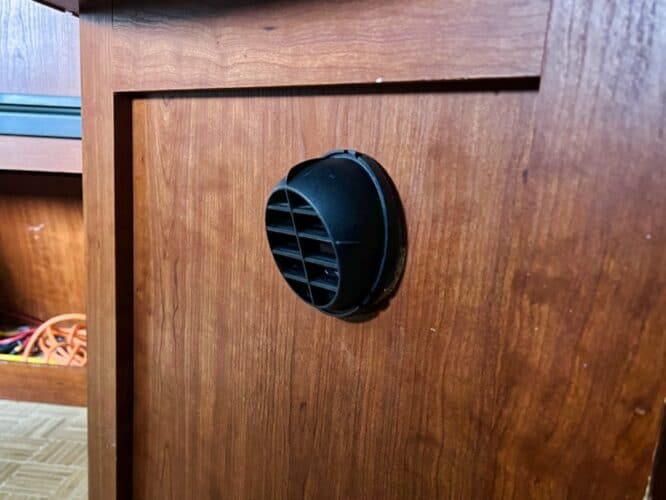
Once everything was installed the vent looked great. It’s under the main bed and not very noticeable.
If your diesel heater didn’t come with a vent you can get one here (click to view on Amazon).
The vent rotates so I can direct the heat to where I need it.
Airflow
Diesel heaters use a lot of air for both the fan and the motor.
Make sure you use an RV storage area that’s big enough to give the unit space to breathe.
You also don’t want to put anything flammable nearby just in case.
The storage compartment on my motorhome has two doors.
One giant one that you can see in most of my pictures and a smaller one on the back of the RV.
See Also: Best 12 Volt RV Lithium Battery Reviews + How To Charge
When using the diesel heater, I close the big door to stop exhaust from blowing back into the heater and I crack open the back door to let in some fresh air.
This not only keeps the diesel heater running safely, it also helps keep the inside of my RV from smelling like heated plastic.
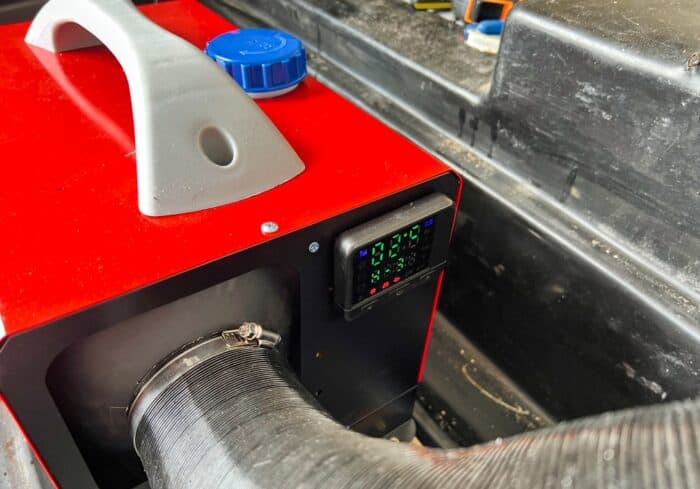
Controls
Diesel heaters are controlled via an LCD screen usually located on the front of the unit.
In the case of my Vevor diesel heater (click to view current model on Amazon), there is a 3 button LCD screen and remote control that can be used to start, stop, and increase or decrease the heating.
I use the remote to control the heater while inside my RV. Luckily for me, it works well even through RV walls.
Some people have trouble with the remotes that come with Chinese diesel heaters, but so far mine has worked fantastically.
The only downside is I don’t know what heat setting it’s at, but I normally leave it set to 3 at all times.
So it’s not that big of an issue for me.
Model Update Info:
Since writing this article, Vevor has released an updated version of their 8KW portable diesel heater.
Most of the features and included parts are still the same, but there are a few nice additions that make it easier to control the heater from afar.
Bluetooth has been added so you can control the heater from an app on your smartphone.
This eliminates the issue of not knowing what the heater is set at.
It also makes it way easier to change settings since the phone controls are easier to see and understand than the LCD screen ones.
Diesel Heater RV Heating Test
I talk about the testing I did of the Vevor diesel heater in this post here, but I’ll give a quick overview of the results so you can get a good idea of how well these portable diesel heaters work.
It’s freezing where I’m at right now. So when I started my tests it was 32°F outside.
I started by seeing how fast the heater could heat my 24 foot motorhome on the medium setting (H-3).
On the 3 setting the inside temperature of my RV went from 32°F to 40°F in one hour.
The wind was pretty strong during that test and I think on a calm day it could have raised it 10°F in an hour.
On the highest setting (H-6) it was able to take the RV from 32°F to 46°F in one hour, that’s a 14°F increase in freezing temperatures.
In just 2 hours my small motorhome was comfortable and after 3 I could take my coat off.
See Also: Best Deep Cycle RV Battery (AGM, SLA, 12V, 6V)
One nice thing about diesel heaters is once you get your motorhome warmed up you can set it to the lowest setting to maintain the temperature.
It’s also very quiet compared to the RV furnace. It’s mostly just the sound of the air coming out of the vent.
I can’t hear the pump through the walls of my RV so it doesn’t bother me at all.
Note that heat is coming out of just one 3 inch vent.
If you have a larger RV you can get a model like this one by Vevor (click to view on Amazon) that has 4 heat outputs so you can put vents in more than one spot.
Also, the heat duct I use isn’t insulated.
It releases quite a bit of heat into the storage compartment. I plan on insulating it later to direct more heat into the RV.
I may even split the duct using this kit (click to view on Amazon) to add another vent inside the RV.
Energy Usage
As far as electricity goes my 3 hour tests hardly affected my 1oo ah 12 volt lithium battery.
It only went down 1%, from 100% to 99%. I could easily run this heater for days without having to recharge my lithium battery.
This is a huge pro for boondockers.
RV furnaces use around 150 watts every hour just to run the fan, which means your RV battery will be totally drained in just one night.
With a diesel heater, you don’t have to worry as much about the electrical part of heating.
Fuel Usage
Refilling the diesel tank is the main thing you will need to do with a portable diesel heater.
The highest setting uses around 1/2 a liter of diesel an hour.
The tank only holds 5 liters so if you have it on full you will need to refill the tank after 9-10 hours.
You shouldn’t need to have it on the highest setting though.
See Also: How To Install Solar Panel On RV Roof & Connect To Battery
Once I got the RV heated up it was maintained by the lower settings easily, which means you can get more like 20-30 hours of runtime before needing to refuel.
The cost of diesel fluctuates a little bit more than propane.
Sometimes it will be very inexpensive to use your diesel heater, and other times it might be a little bit more.
Overall it’s still a budget friendly way to heat since it doesn’t use a ton of fuel.
Portable Diesel Heater Install Conclusion
I’ve been very happy with my Vevor portable diesel heater installed in the storage compartment of my RV.
It’s way better than my RV furnace, especially in my tiny RV.
The furnace is crazy loud since I’m sitting right next to it no matter where I am in it.
So the diesel heater is a fantastic upgrade as far as noise goes.
Since my RV has an onboard propane tank that requires me to move the motorhome to refill.
It’s nice to be able to use a more portable fuel source like diesel.
The very low power usage has also been a huge plus for me since I use solar power and batteries most of the time when I’m out camping.
See Also: Best Portable Solar Panel Charger For RV Camper/Boondocking
I’ve finally got a heater I can run all night long without killing my RV battery. It makes camping in colder weather way more comfortable.
When I move my RV the only thing I do is take off the exhaust pipe.
It’s a little tricky getting the drill bit inside the metal box the diesel heater is housed in and I think I’ll try to come up with a better solution later.
But so far it works fine to just remove the exhaust pipe completely from the diesel heater.
I have a 3 inch PVC sewer plug I screw into the hole in the bottom of the storage compartment to seal it up.
Once that’s done I’m ready to hit the road.
Have any questions about installing a portable all-in-one diesel heater in an RV or van? Leave a comment below.

